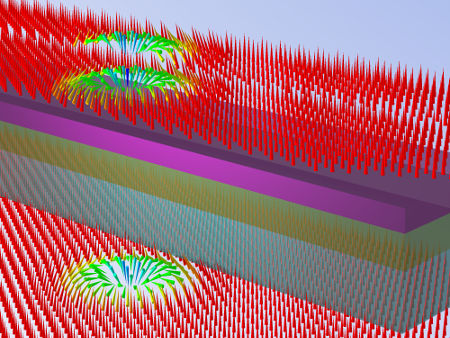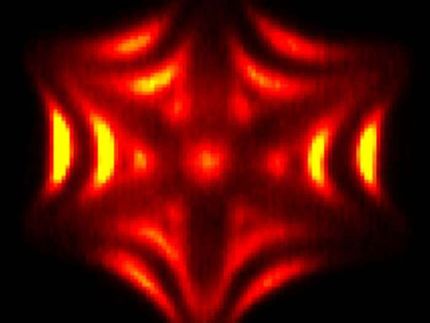Skyrmions a la carte
Magnetic vortices - so-called skyrmions - were predicted theoretically more than 25 years ago, but it has only been possible to observe them experimentally in magnetic materials in recent years. Skyrmions are stable, can have a diameter of just a few nanometres, and can be moved efficiently by electrical currents. Therefore, they are presently being discussed as candidates for high density, energy-saving data storage and processing. However, until very recently, the only materials known to exhibit skyrmions did so at extremely low temperatures. Scientists at Kiel University and the research institute Forschungszentrum Jülich have predicted that skyrmions can also be produced for applications at room temperature - and their properties specifically adjusted - when enveloped in magnetic layer structures.

Tiny magnetic vortices with a diameter of just a few nanometres in a metallic layer structure. The diagram represents the “atomic bar magnets” of each magnetic atom by means of a small coloured arrow. The red, upward-pointing arrows show a homogeneous ferromagnetic background. In the magnetic vortices – the skyrmions – the “atomic bar magnets” of the iron atoms spin around (orange and green arrows) and have an opposite orientation in their centres (blue arrows).
Bertrand Dupé, CAU
The team, headed by the physicist Dr. Bertrand Dupé, is sure that each skyrmion could store 1 bit of information. The small size of the vortex allows a very high density to be achieved. In contrast with hard drive disks, which are rotated to enable data to be entered or read out, in the case of skyrmion-based devices the Bits could simply be moved right through the material, similar to how electricity flows through a wire. No mechanical moving parts would be required - only weak electrical currents, which saves energy. In addition, once the computer is switched on, the data is available immediately, as it is stored in non-volatile memory. The envisaged devices required could be manufactured with standard technologies currently used in industry.
Skyrmions were first observed experimentally in 2009, in exotic crystals at temperatures close to absolute zero. In the meantime, these unique magnetic structures can also be found on metallic surfaces, as used today in technological applications such as magnetic sensors or the reading heads of hard drives. In order to use skyrmions as a storage medium, it must be possible to manufacture the boundary surfaces on a sufficiently large scale, they must contain enough of the magnetic material, and the magnetic vortex must also occur at room temperature.
Suggestions on how to overcome these challenges have been made by the scientists from Kiel University and Forschungszentrum Jülich in their currently published study. Here, they show that the magnetic properties of the boundary surfaces can be specifically adjusted by layering different metals very thinly on top of one another. Each of the layers is only a few atoms thick. "By using quantum-mechanical calculations, which were carried out on the supercomputers at Forschungszentrum Jülich and the North-German Supercomputing Alliance (HLRN), we were able to investigate a multitude of possible systems," said Professor Stefan Heinze from Kiel University. The multiple repetition of such layers ensures that there is enough magnetic material and that it should also be possible to produce skyrmions at room temperature, Heinze continued.
"Our study provides the experimenters with recipes for making skyrmions to order," explained Bertrand Dupé. It has recently been proven that these theoretical recipes from the supercomputers can also be implemented in practice. "The idea of producing skyrmions in layer systems has already been taken up by a number of research groups all over the world. A few months ago, several publications reported the successful experimental observation of skyrmions," said Dr. Gustav Bihlmayer from Forschungszentrum Jülich. The theoretical basis for these experiments is provided in their latest publication, continued Bihlmayer.
However, there is still a long way to go until the first memory applications based on magnetic skyrmions are produced. The development of prototypes of magnetic data storage is being investigated by the Kiel and Jülich scientists in the joint project MAGicSky. The experimental tasks are carried out by colleagues from Germany, France, Great Britain and Switzerland. The research is subsidised by the European Union within the Future Emergent Technologies programme.



























































